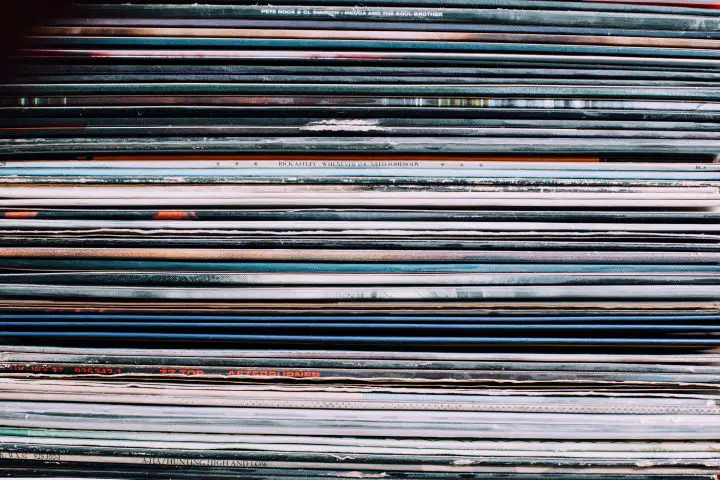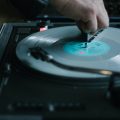What is vinyl record grading? And how exactly does it work? Well, this is precisely what we seek to answer for you today, so come on in from the cold!

Table of Contents
What exactly is Vinyl Record Grading?
Grading is an integral aspect of collecting vinyl records. Over time, records accrue signs of wear and age that diminish audio quality and value. A standardized grading scale allows collectors, resellers and archivists to assess condition consistently.
Understanding record grading provides insight into an album’s sound quality, rarity, and investment potential. For casual listeners or newcomers, grades offer a snapshot of what to expect before dropping the needle.
Brief History
Grading terminology emerged organically from record stores and early collector markets. Descriptors like “mint” and “very good” were adopted to connote tangibly how well a record held up. These qualitative grades were later codified into a unified ranking system still used today.
Grading’s Role in Collecting
As monetary value entered the equation, condition grades became pivotal. Collectors vie for coveted pressings in flawless shape – where higher grades mean higher prices. Precise grading prevents exaggeration while enabling remote purchases. Archivists also rely on grades to prioritize at-risk records for remastering efforts.
What Impacts Grading
Visually inspecting labels, groove wear, scuffs and cover condition is central to grading records. However listening for pops, clicks and sibilance is equally important in gauging playability. Press quality, storage and sleeve integrity also affect grade assessments. Evaluating these multifaceted elements requires nuanced expertise.
What Determines a Vinyl Record’s Grade?
Evaluating the multitude of elements influencing record condition seems daunting at first. However, there are key criteria to focus on when assessing vinyl. While equipment helps, the trained ear and eye reign supreme in detecting subtle flaws.
Visual Inspection
A record’s visual appearance reveals much about its history. Checking labels for scuffs, the grooves under light for fuzziness, and the vinyl for major scratches comes first. Covers should be examined for ring wear, seam splits, tears and so on.
- Minor cover flaws like dinged corners can bring Near Mint down to Very Good. Matrix numbers etched in the dead wax also provide pressing insight.
Audio Quality Checks
Listening tests help grade items that look pristine. Signs like surface noise, pops, clicks and distortion must factor into appraisals. Audio grades diminish if:
- Repeated ticks or crackles emit
- Songs lack clarity or dynamics
- Pitches waver due to warped vinyl
The highest grades require quiet backgrounds and clear reproduction.
Pressing Quality Considerations
Pressing quality transcends both audio and visual grades. Well-pressed records better withstand minor scuffs or light surface noise. Fuzzy definition or groove echos indicate below average press quality.
Next, checking labels and covers for seam splits or delamination gives clues into pressing and sleeve integrity. Mastering notes, equipment used and pressing pedigree all elevate collectability.
Understanding the Vinyl Grading Scale
The vinyl grading scale categorizes records into qualitative condition tiers. At a glance, the grades provide collectors and archivists shared terminology to uniformly assess state. From pristine Mint ranking down through various levels of wear, these rankings offer common ground.
- Mint (M) – Flawless new condition
- Near Mint (NM) – Virtually untouched
- Very Good Plus (VG+) – Light scuffs acceptable
- Very Good (VG) – Noticeable signs of use
- Good (G) – Significant wear
- Fair (F) – Heavy damage
- Poor (P) – Barely playable
Mint Condition (M)
Grading vinyl records that are deemed to be in mint condition will be those considered perfect and unmarred, more or less coming in a condition that is brand new. The disc itself will be untouched by surface marks, groove wear, ring wear, surface noise, or anything that might otherwise affect the overall sound quality.
Likewise, this quality will also be reflected in the record’s sleeve, which will be entirely unaffected by any light marks or anything that would otherwise eschew the appearance of it being brand new. Many mint-condition records, in fact, still come in their original plastic wrapping.
It is, however, not too difficult to rewrap a record in cellophane wrap in this way, so any record collector looking to purchase a record in this way ought to be seriously careful where exactly they tread, lest they end up with a record that bastardizes the whole vinyl grading system under the guise of a sealed album.
Near Mint Condition (NM)
In being so closely associated with a mint condition record, an NM record is going to be only slightly out of the reach of being a mint condition record. Where the former will almost certainly never have been opened or played before, the latter will tend to have been opened and either never played or only played a few times.
A near-mint condition record will thus be almost entirely perfect, bearing next to no marks on the record itself or the sleeve within which it is contained, unlike some more used records and vinyl albums.
Record collectors are likely to come across a near mint value record far more frequently than its other namesake, as sellers are reluctant to call designate something as mint in condition, preferring instead to simply call it ‘brand new,’ or something similar. Near-mint NM is something to aspire to.
Excellent Condition (E)
Following on sequentially, there is a very slight lessening of quality between a near-mint record and an excellent condition record. One of the key indicators between the two is the presence of stress marks on the latter, which bear the resemblance of a few light scuffs born as a result of removal and insertion into the record sleeve, something that is further exacerbated with repeated use and listening.
The gradations in quality between a near-mint record and an excellent record will be rather subjective, though in the case of the latter, there is at least a bit more of a tolerance for very minor signs of wear and light visible scratches on the album cover and elsewhere that are barely noticeable.
A record of this grading will still only have been played a few more times than a near-mint record in the grand scheme of things.
Very Good Plus Condition (VG+)
Decreasing in overall quality ever so slightly as we move on sequentially, we reach the VG+ category of record. A record exhibited and sold at this level of the grading might indeed be marred by light scratches, light ring wear, or more. However, no matter what, the marks, scratches, etc, should not hinder the quality of playback.
And the same goes for the sleeve, too, for this is truly something that is supposed to be enjoyed in its own right. No matter the guide to vinyl record sizes, the album art is still going to be printed on a large enough form for the resident record collector to sit back and admire it with knowingness.
Therefore, if a record has been kept in a strong light for a considerable amount of time (enough that the sleeve is sun-bleached and the like), then its currency is no good here.
Very Good Condition (VG)
Though there is little, as ever, that separates this category of grading from the previous, that which does is of the utmost significance.
While there is no allowance in the prior category for the various marks and scratches to hinder the sound quality, with a VG record, there is at least some, meaning that small detriments to the overall quality of audio playback are more or less to be expected.
This allowance does not delve much further than slight clicks and pops, erstwhile signs that a record was much loved, both in the care that was attended to it and the eventual hairline marks and scratches that were an inevitable result of its frequent spinning.
There is, however, no place for significant surface noise and the like, nor anything else that is going to put a constant strain on the quality of the audio playback. As seen, VG records are perfectly powerful and a great condition to pick up rare records in, usually only exhibiting some minor wear.
Good Condition (G)
A G-rated record will be one that exhibits the many telltale signs of a life spent gladly beneath the needle. There will be a significant and frequently noticeable deterioration in the overall listening experience, to the chagrin of some and the aggravation of others.
Likewise, the sleeve itself will be subject to a whole host of distortions and detriments, including marks, bends, scuffing, folding, spine splits, and even discoloration as a result of overexposure to UV rays, having not learned the art of storing records. Buy yourself a record crate and get stuck in.
At this point in the grading system, we have already reached a touching stone that many buyers simply refuse to touch unless entirely desperate or unless provided with no other choice. Thus, it is recommended only to sell at this level and certainly only to do so if desperate oneself or if the record is a rare one that is likely to fetch a considerable sum.
So, to grade vinyl records is to attempt to sidestep such disappointment in the future, especially in an online record store like Discogs. Such a record store will always use a metric like this for precisely this reason.
Fair Condition (F)
On a record of this variety, there will be a considerable degree of damage, both visually and in terms of audio playback, with significant ring wear left, right, and center. Light scratches deep into the makeup of the record, minor writing on the record’s jacket, major noise issues, etc.
The sleeve itself will tend to be gravely affected by distortions, sun-bleached as in previous categories, though this time at a level taken to extremes. It is not altogether uncommon for a record in this category to even be without a sleeve entirely, coming instead in an inner jacket bound within a cellophane wrapping of sorts.
These once were wonderful records pressed brand new, and sadly they have either been much loved over the years to the point where the listening experience they contain has been seriously compromised or have been mistreated and abused to a similar degree.
The central difference between these two courses is that in the former, the record will likely have lived a longer and happier life in the hands of an owner who loved and cared for them. In the latter, not so much.
Poor Condition (P)
A record of poor condition will be scarcely even able to play properly and consistently owing to the defects present on the surface. You certainly would not be finding a record like this in a retail store unless it has been recycled into something else, of course.
As with a record in fair condition, it is not uncommon for a record in poor condition to be without a record sleeve altogether. Certainly, if it does come with one, it will be in a compromised and ill condition, with seams and splits that mean it can barely stay in one piece, along with the various other aspects of distortion that characterized the previous few pegs of the vinyl grading system.
Sometimes, there will even be chunks missing, cut-out markings from years gone by, or else the various extra pieces of the package will be marred or missing.
Bad Condition (B)
And finally, at the very end of the veritable spectrum of viny record grades, we have a record that is deemed to be in bad condition. You are rarely, if ever, going to find a record in such a condition as this, but I suppose it is worth knowing what to look for, even if it is only for my peace of mind in rounding off this list.
A record listed in such a category will be borderline unplayable by the very definition of being labeled bad, no matter how many actual records that can be spun perfectly you might deem ‘unplayable’.
Likewise, a bad record is more likely to be scant off the sleeve than not, which may even be one of the reasons it is no longer playable, having garnered so many scratches, bumps, and warts along the way without shelter.
Grading Your Own Vinyl Records
Cataloging and grading your personal vinyl collection takes time but pays dividends. Not only does proper grading help safeguard value, it also prevents buying duplicate copies of what you already own.
When self-grading, the key lies in conservatively assessing condition. Grade harshly and leave room for better appraisals down the line. It also helps listening on high-quality equipment to catch subtle audio flaws.
Step-by-Step Visual and Audio Checks
Adopt a methodical grading process for each record, moving between inspection, cleaning and close listening. Note identifiers like matrix etchings too.
- Visually scan labels and playing surfaces first under bright light. Search for scuffs, hairline marks, wear.
- Use a high-quality record cleaning system to remove debris before audio checks.
- With clean vinyl, cue up a dynamic track and listen intently across channels. Flag repetitive ticks, pops hiss or distortion.
- Check vinyl rim and spindle hole for discoloring. Inspect cover condition.
- When doubtful between two grades, be conservative and choose the lower one.
Establishing this inspection workflow takes patience but in time becomes second nature. Maintaining online discogs inventories also aids the grading process through comparison.
Resources for Grading Assistance
When stumbling upon tricky pressings lacking indicators or pressed off-center, turning to resources can aid accurate grading. From online databases to experts at record stores, multiple channels provide authoritative perspectives.
Online Price and Condition Guides
Websites like Discogs allow searching vast databases listing vinyl sales histories, complete with images. Comparing your records to graded examples builds grading instinct. Absorbing notes from experienced sellers also provides context behind grade rationales.
Seek Input From Local Record Stores
Vintage record dealers constantly assess varied collections spanning every era. Few can match that breadth of exposure. Come armed with your challenging, borderline call records and ask staff like:
“Where would you peg this old blue note LP? I’m wavering between a Very Good and Very Good Plus grade”
Feedback helps avoid under/over-grading. Foster those connections.
Utilize Grading Tools
Devices like USB microscopes assist grading by revealing groove clarity. Scales ensure accurate assessments of warping. Investing in tools pays dividends through increased grading confidence and precision.
Lean on these resources to accurately grade stranger pressings. But also trust your instincts—they strengthen over time through first-hand, trial-and-error experience.
Final Tones
So, there you have it! Hopefully, this article on vinyl record grading system has been of some use to you!
By learning the standards that collectively define mint condition to poor, collectors and casual listeners alike can speak a common language that transcends individual pressings. This empowers everyone to build, buy, sell, catalog and cherish vinyl in ways that endure.
Can you get vinyl records graded?
Indeed you can, though you can just as easily do it yourself as long as you follow the specific guidance above.
What does VG ++ mean for vinyl?
Vinyl in this category might exhibit some marks and signs of wear, but this should never be at the expense of playback. The same goes for the sleeve too, where no marks should affect the experience of looking at it.
Is there a company that grades vinyl records?
Sure, there are several, but you can very easily do it yourself by following the metric guidance about it online.
What does G+ mean for vinyl?
A record in this category will exhibit some signs of wear and tear that come with being well-loved. These signs may also get in the way of the listening experience a little.






